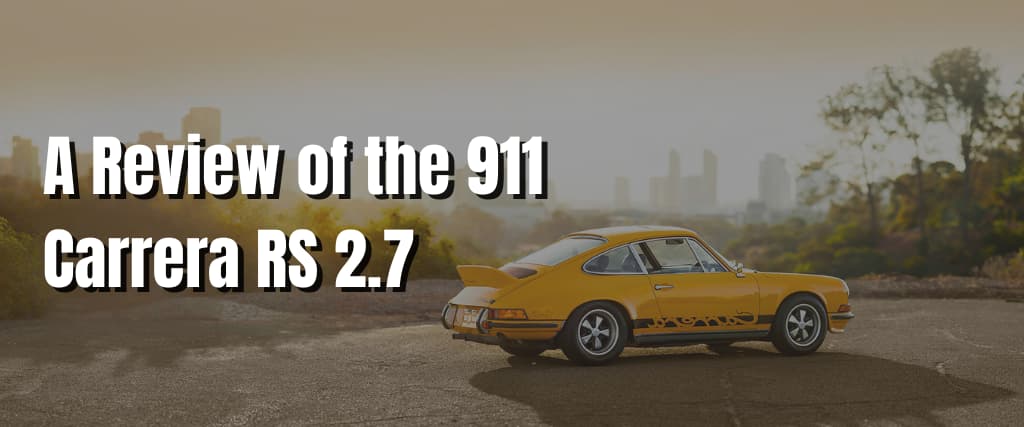When it comes to iconic sports cars, the Porsche 911 Carrera RS 2.7 is right up with the best of them.
Introduced in 1973, the vehicle was an instant sensation when it came out, captivating enthusiasts with its distinctive design, exhilarating performance, and remarkable handling.
Even today, some 50 years later, it remains a benchmark for sports cars and an object of desire for collectors and enthusiasts alike.
In this article, we will take a closer look at this remarkable vehicle, examining some of the factors which make it so adored within the automotive industry.
Heritage and Legacy

The heritage of the Porsche 911 Carrera RS 2.7 is deeply rooted in motorsport excellence. It was originally introduced as a homologation special to meet racing regulations. However, it quickly became an icon both on and off the track.
Standing for ‘Rennsport’ – the German name for ‘racing sport’ – the RS was born out of Porsche’s desire to create a lightweight, high-performance variant of the 911. The goal was to produce a limited number of road-going models that would allow Porsche to compete in the Group 4 racing category.
When it was unveiled, the Carrera RS 2.7 introduced the iconic ‘ducktail’ rear spoiler, which enhanced aerodynamic stability and became an unmistakable design feature closely associated with the model. Its wide fenders and distinctive graphics further emphasised its aggressive appearance.
The vehicle made a significant impact on the racetrack, achieving numerous victories and class wins in endurance races such as the Targa Florio and the 24 Hours of Daytona. Its success in motorsport solidified its reputation as a formidable racing machine and further cemented the Porsche 911’s legacy as a dominant force in motorsport.
Beyond its racing pedigree, the 911 Carrera RS 2.7 has become highly coveted by collectors. Its limited production run of approximately 1,580 units (including both Touring and Lightweight variants) adds to its exclusivity and desirability. Indeed, today, it is considered one of the most sought-after classic Porsches, with pristine examples commanding high prices at auctions.
Design and Styling
The design and styling of the Porsche 911 Carrera RS 2.7 are a perfect embodiment of the era in which it was born.
An iconic sports car, it features a distinct and classic silhouette that defines the 911 lineage, with a sloping rear end, roofline, and unmistakable shape. However, it also incorporates several design elements that set it apart from its standard counterparts, thus making it instantly recognisable.
One of the most iconic design features of the Carrera RS 2.7 is its ‘ducktail’ rear spoiler. Located above the engine cover, this raised rear spoiler improves aerodynamic stability at high speeds and enhances the car’s overall performance.
Another notable design element is the wide and muscular rear fenders, which give the Carrera RS 2.7 a more aggressive stance compared to other 911 models. These flared fenders accommodate wider wheels and tires, emphasising the car’s performance-oriented nature while also improving grip and handling.
At the front, the vehicle has a distinctive bumper with integrated fog lights and a low-slung air intake. These elements contribute to improved aerodynamics and give the car a purposeful and aggressive front-end appearance.
The Carrera RS 2.7 is often adorned with iconic graphics and decals that further enhance its visual appeal. The contrasting-coloured ‘Carrera’ side script and various stripes and badges accentuate the car’s racing pedigree and add a touch of vintage charm.
Inside, its design continues the theme of simplicity and functionality. The driver-focused cockpit features a minimalist layout with essential controls and gauges placed within easy reach. The seats are typically lightweight sport seats, providing excellent support during spirited driving.
Performance and Powertrain

This iconic sports car was designed to deliver an exhilarating performance and have an engaging driving experience that has stood the test of time.
At the heart of the Carrera RS 2.7 lies a 2.7-litre, naturally aspirated flat-six engine known for its rev-happy nature and throaty exhaust note. Depending on the specific variant and tuning, this high-revving engine produces impressive power outputs, ranging from 210 to 255 horsepower. The power is also sent to the rear wheels, allowing for pure and unfiltered driving dynamics.
The lightweight construction of the vehicle, combined with its powerful engine, results in impressive performance figures. Acceleration from 0 to 60 mph (0 to 97 km/h) takes around 5.5 seconds, depending on the variant, while top speeds reach up to 150 mph (240 km/h). These figures were highly impressive for the time and contributed to the Carrera RS 2.7’s reputation as a potent sports car.
The car’s power is transmitted through a precise and responsive manual gearbox. It typically features a five-speed manual transmission that offers short and precise shifts, allowing drivers to extract the maximum performance from the engine. The gear ratios are well-matched to the engine’s powerband, providing excellent acceleration and flexibility in various driving conditions.
To complement its performance capabilities, the Carrera RS 2.7 features a well-tuned suspension system that strikes a balance between handling prowess and driver comfort. It typically incorporates revised suspension components, including stiffer springs, uprated dampers, and anti-roll bars. This setup enhances the car’s agility, responsiveness, and overall handling characteristics.
Furthermore, the Carrera RS 2.7 benefits from improved braking capabilities. It is equipped with larger disc brakes, typically ventilated at the front, which provide excellent stopping power and fade resistance. This ensures confidence-inspiring braking performance, allowing drivers to push the car to its limits on both the road and the track.
Interior Comfort and Features
The interior of the Porsche 911 Carrera RS 2.7 is focused on providing a purposeful driving environment with a strong emphasis on performance. While it may not offer the luxury amenities found in contemporary sports cars, it delivers a driver-focused cockpit that enhances the overall driving experience.
The seating typically consists of lightweight sport seats designed to offer excellent support and hold the occupants firmly in place during spirited driving. These seats prioritise performance and are often finished in a combination of fabric and vinyl upholstery, reflecting the era’s racing-inspired design.
Its dashboard layout is straightforward and functional, with a focus on ergonomics. The essential controls and gauges are intuitively placed within easy reach of the driver, allowing for quick and convenient access to vital information while on the move.
In terms of creature comforts, the Carrera RS 2.7 does not prioritise luxury amenities. Features like air conditioning and sound systems were often omitted to save weight and enhance the car’s performance-oriented nature. This approach aligns with the vehicle’s purpose as a track-focused sports car.
While the interior may be relatively minimalist, the craftsmanship and attention to detail are still evident. The materials used are of high quality, and the fit and finish are generally excellent, reflecting Porsche’s commitment to delivering a premium driving experience.
Despite its lack of luxury features, the vehicle compensates by providing an immersive driving experience. The cockpit envelops the driver, placing all the necessary controls within easy reach, creating a strong connection between the car and the driver.
Driving Experience and Handling

The driving experience and handling of the car deliver pure driving pleasure.
One key factor contributing to this is its excellent weight distribution. The rear-engine layout, a hallmark of the 911, provides a unique balance that enhances the car’s agility and handling characteristics. This weight distribution and the car’s lightweight construction allow for precise and predictable handling, enabling drivers to feel connected to the road.
The steering of the Carrera RS 2.7 is well-weighted and highly responsive, and communicative, providing excellent feedback to the driver. It offers precise turn-in and allows for confident and accurate placement of the car in corners.
Likewise, its suspension set-up is performance-oriented, featuring stiffer springs, uprated dampers, and anti-roll bars. This setup enhances the car’s cornering ability, offering minimal body roll and allowing for flat and controlled handling. It also enables the Carrera RS 2.7 to exhibit exceptional balance, inspiring confidence through corners and providing an even more rewarding driving experience.
Additionally, the vehicle benefits from a well-tuned braking system. The larger disc brakes, often ventilated at the front, provide excellent stopping power and consistent performance. This ensures precise and confidence-inspiring braking capabilities, allowing drivers to push the car to its limits while maintaining control and composure.
Overall, the car’s driving experience is characterised by its engaging and immersive nature. It rewards the driver with its precise handling, nimble responses, and the exhilarating engine note that accompanies its rev-happy nature.
Ownership and Collectibility
As a highly coveted classic car, owning a 911 Carrera RS 2.7 represents a significant milestone for Porsche enthusiasts and collectors. Its rarity adds to its allure, as only 1,580 units were produced. The limited production numbers and the car’s outstanding performance and historical significance make it a prized possession among automotive connoisseurs.
The collectibility of the vehicle is further enhanced by its racing heritage. The model’s roots trace back to the motorsport-inspired homologation process, where Porsche produced limited road-going versions to meet racing regulations. This association with motorsport not only adds to the car’s desirability but also contributes to its enduring appeal and value.
Over the years, the car has appreciated significantly in value, making it an attractive investment for collectors. Its rarity, iconic status, and timeless appeal of the 911 lineage have contributed to its steady increase in worth. Well-preserved and original examples command premium prices on the market, often surpassing the original purchase price several times over.
Owning a 911 Carrera RS 2.7 brings with it a sense of exclusivity and pride. Additionally, driving one allows enthusiasts to connect with the rich heritage of Porsche and experience the thrill and excitement that this iconic sports car delivers.
That said, it is important to note that owning and maintaining a 911 Carrera RS 2.7 requires careful consideration. Due to its age and limited availability of certain components, restoration and maintenance can be challenging and expensive. Therefore, finding a well-documented and properly maintained example is crucial to ensuring the long-term value and enjoyment of the vehicle.
Conclusion
It is not too much of a stretch to say the Porsche 911 Carrera RS 2.7 is an automotive legend that continues to captivate modern car enthusiasts. With its exceptional heritage, stunning design, exhilarating performance, and engaging driving dynamics, it has firmly established itself as an icon in the world of sports cars.
However, the legacy of the 911 Carrera RS 2.7 extends far beyond its initial production years. Indeed, it set a benchmark for future performance-oriented 911 models, inspiring subsequent generations of track-focused variants like the 911 GT3 and GT3 RS.
Moreover, its timeless design, exceptional performance capabilities, and storied racing heritage continue to captivate automotive enthusiasts and serve as a testament to Porsche’s engineering prowess.
Ultimately, though, the car is best known for standing as a testament to Porsche’s commitment to performance, innovation, and the pursuit of driving perfection. For this reason, it will continue to hold a special place on the automotive landscape for many years to come.


